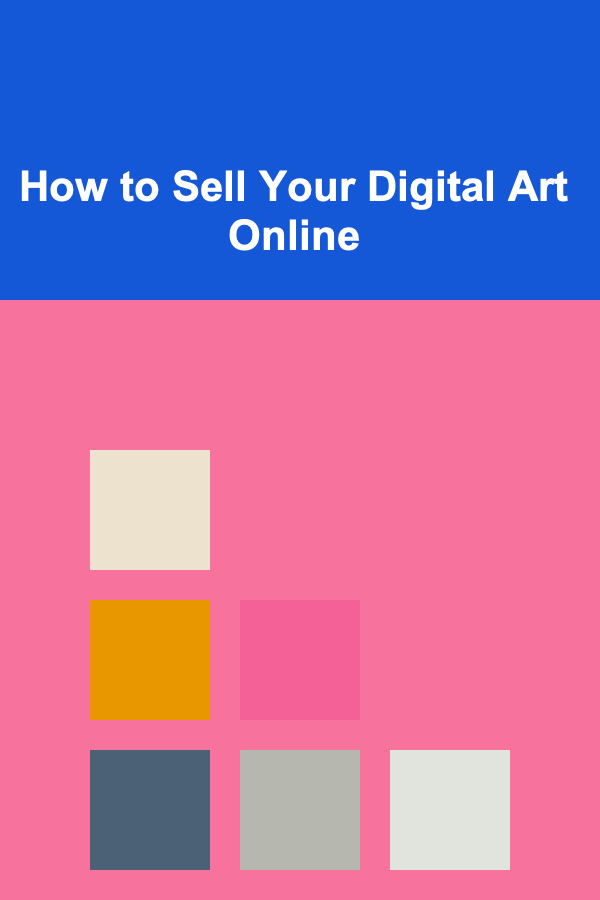
How to Sell Your Digital Art Online
ebook include PDF & Audio bundle (Micro Guide)
$12.99$9.99
Limited Time Offer! Order within the next:

In the rapidly evolving world of digital art, selling your creations online has never been more accessible or more lucrative. Whether you're a seasoned artist or a beginner, the internet provides numerous platforms and tools to help you monetize your digital artwork. This comprehensive guide explores the various strategies, platforms, and tips for successfully selling your digital art online. By the end of this article, you will have a clear understanding of how to turn your creative passion into a profitable venture.
Understanding the Digital Art Landscape
Digital art is a broad category that includes art created using digital tools, such as illustration software (e.g., Adobe Photoshop, Illustrator, or Procreate), 3D modeling programs, and digital painting applications. Digital art encompasses many forms, including:
- Illustrations and Drawings: These can be hand-drawn or digitally created, often in the form of characters, portraits, or abstract designs.
- Graphic Design: Logos, marketing materials, and other design work are often in demand.
- 3D Art: This includes 3D models, digital sculptures, and environments used in gaming, animation, or virtual reality.
- Photography: While photography is technically a form of traditional art, digital photography has become an essential part of the digital art world, with many photographers selling their digital images online.
- Animation and Motion Graphics: Short animations or motion-based art often have a market in entertainment, marketing, and social media.
The digital art world is vast, and online selling has made it possible for artists to reach global audiences, establish their brands, and earn a living from their craft. However, with so many artists vying for attention, it's important to understand the strategies that work best to get noticed and make sales.
Step 1: Build a Strong Portfolio
Before you even think about selling your digital art online, you need a solid portfolio. A portfolio serves as your digital resume, showcasing your best work, style, and creative range. Having a well-curated portfolio is crucial in making a good impression on potential buyers.
What to Include in Your Portfolio
- Best Pieces: Only display your strongest and most representative pieces of work. Quality always outweighs quantity. The goal is to show potential buyers what you're capable of and why your art is worth purchasing.
- Diverse Range: While showcasing your best work is essential, it's also important to show versatility. This helps you appeal to a broader audience. For example, if you mainly create character illustrations, consider adding some logo designs or 3D art to demonstrate your range.
- Personal Branding: Your portfolio should reflect your personal brand as an artist. This includes your style, themes, and tone. A consistent and identifiable style can help you stand out in a crowded market.
- Professionalism: Make sure your portfolio looks polished and well-organized. Use a clean layout, and avoid clutter. It should be easy for visitors to browse and find what they're looking for. Consider adding an "about" section that tells the story behind your work and your journey as an artist.
- High-Quality Images: The quality of the images you display is vital. Use high-resolution images that showcase your art in the best light. Blurry or poorly lit photos will hurt your chances of making sales.
Platforms for Creating an Online Portfolio
There are several platforms where you can showcase your digital art portfolio:
- Behance: Owned by Adobe, Behance is one of the most popular platforms for creatives. It allows you to build a professional portfolio and network with other artists.
- Dribbble: Dribbble is ideal for graphic designers, illustrators, and digital artists. It functions both as a portfolio platform and a community where artists can get feedback and visibility.
- ArtStation: This platform is tailored to digital artists, especially those in the gaming and entertainment industries. It's a great place for showcasing concept art, 3D models, and animations.
- Your Website: Building your own website gives you full control over your portfolio. You can use platforms like Wix, Squarespace, or WordPress to easily create a website that represents your personal brand.
Step 2: Choose the Right Platform for Selling Your Art
Once you've built your portfolio, it's time to decide where you will sell your art. Several online platforms cater specifically to digital artists, each with its advantages and disadvantages. Choosing the right platform is crucial for maximizing your sales potential.
1. Etsy
Etsy is one of the most popular online marketplaces for handmade, vintage, and digital products. It has a large community of buyers and sellers and is particularly effective for artists selling digital downloads like illustrations, printables, and digital patterns.
Pros:
- Large, active user base
- Easy-to-use setup process
- Good for selling digital products like prints, illustrations, and downloadable assets
- Option to sell physical items as well (e.g., prints, stickers, etc.)
Cons:
- Fees for listing items and transaction fees
- High competition
2. Redbubble
Redbubble is a print-on-demand marketplace where artists can upload their designs, which are then printed on a variety of products like clothing, accessories, home decor, and stationery. Artists earn a commission each time their design is sold.
Pros:
- Passive income model (you don't need to handle inventory or shipping)
- Wide range of products available for your designs
- Global audience
Cons:
- Limited control over pricing
- Less branding flexibility
3. Society6
Similar to Redbubble, Society6 is another print-on-demand platform where artists can upload their artwork to be printed on various products. Society6 focuses more on high-quality art prints and home decor items.
Pros:
- High-quality print options
- Passive income through print-on-demand
- Artistic community of creators
Cons:
- Lower profit margins due to production costs
- Limited customization options
4. Creative Market
Creative Market is a platform that allows artists to sell digital products like fonts, templates, graphics, and illustrations. It's perfect for those who create assets that can be used by other creatives in their own projects.
Pros:
- Focus on digital assets (e.g., vectors, graphics, fonts)
- Active creative community
- Wide range of customers from different industries
Cons:
- Competitive market
- Commission fees for sales
5. Self-Hosted Website (Shopify, WooCommerce)
If you want full control over your branding, sales process, and customer experience, consider setting up your own online store using a platform like Shopify or WooCommerce. These platforms allow you to sell digital downloads directly to your customers.
Pros:
- Full control over your store's design and user experience
- No third-party fees (besides transaction and processing fees)
- Ability to build your own brand
Cons:
- Requires marketing and driving traffic to your store
- Need to handle website maintenance and updates
Step 3: Optimize Your Listings for Sales
Creating and uploading your digital art to an online marketplace is just the beginning. To make sales, you must ensure that your listings are optimized to attract buyers. Here's how you can optimize your digital art listings:
1. Clear, Descriptive Titles and Tags
Use clear, descriptive titles for your listings, and make sure to include relevant keywords in the tags and descriptions. Think about what your potential buyers will be searching for and optimize your listings accordingly. For example, if you're selling a digital painting of a cat, your title might be "Digital Painting of a Cute Cat in Pastel Colors," and your tags could include "cat art," "digital painting," and "cute cat illustration."
2. Detailed Descriptions
Write compelling descriptions for each product. Include details like the dimensions (if applicable), the style of the art, the process behind the creation, and any relevant information that could attract potential buyers. Be sure to mention whether the file is for personal or commercial use.
3. High-Quality Mockups
When selling digital art, particularly prints or downloadable products, it's essential to show your work in context. Use high-quality mockups to showcase your art. For example, you can display a digital painting in a stylish frame or show it as a print on a wall. Mockups help potential buyers visualize how the art would look in their space.
4. Pricing Strategy
Pricing your digital art can be tricky. You want to ensure that your prices are competitive, but also reflective of the time, effort, and skill that went into creating the piece. Research what other artists are charging for similar work, but don't undervalue your art. As you gain experience and a customer base, you can adjust your prices accordingly.
Step 4: Promote Your Art and Build a Brand
Selling digital art isn't just about uploading your work to an online marketplace---it's also about building a brand and promoting your art to the right audience. Here's how you can attract more buyers:
1. Use Social Media
Social media is one of the most effective ways to promote your digital art and build a loyal following. Platforms like Instagram, Twitter, and Pinterest are highly visual and perfect for artists to showcase their work. Regularly post your art, share behind-the-scenes content, and engage with your followers to create a sense of community around your brand.
2. Collaborate with Influencers
Collaborating with influencers, particularly those in the art and design space, can help you reach a larger audience. Consider offering free digital art prints in exchange for shoutouts or featuring your work in a sponsored post.
3. Email Marketing
Building an email list is a great way to connect with your audience and keep them updated on new releases, sales, and promotions. Offer a free downloadable print or other incentives to encourage visitors to subscribe to your newsletter.
4. Participate in Online Communities
Join online art communities and forums where you can showcase your work, connect with potential buyers, and get feedback. Websites like DeviantArt, Reddit (e.g., r/Art), and art-specific Facebook groups are great places to promote your art and network with other artists and collectors.
Step 5: Provide Excellent Customer Service
Finally, excellent customer service is key to building a successful digital art business. Respond promptly to customer inquiries, be clear about your terms and conditions, and make sure buyers are satisfied with their purchases. Consider offering refunds or exchanges if there are any issues with the files or products.
Selling digital art online is an exciting and profitable venture for creative individuals. By following the steps outlined in this guide---building a strong portfolio, choosing the right platform, optimizing your listings, promoting your work, and providing great customer service---you can start making money from your passion. With persistence, creativity, and a strategic approach, you can turn your digital art into a thriving online business.

How to Declutter Your Home and Simplify Cleaning
Read More
How to Generate Passive Income by Developing AI SaaS Solutions
Read More
How to Implement Eco-Friendly Practices in Volunteer Spaces
Read More
How to Make Pet-Friendly DIY Projects for Your Home
Read More
How to Organize Holiday Celebrations for Less Stress
Read More
How to Soundproof Your Ceiling to Prevent Noise from Upstairs
Read MoreOther Products

How to Declutter Your Home and Simplify Cleaning
Read More
How to Generate Passive Income by Developing AI SaaS Solutions
Read More
How to Implement Eco-Friendly Practices in Volunteer Spaces
Read More
How to Make Pet-Friendly DIY Projects for Your Home
Read More
How to Organize Holiday Celebrations for Less Stress
Read More